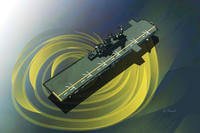Even the commanding officer of Top Gun can end up with one more takeoff than landing.
A command investigation into an Aug. 2, 2016, F/A-18C Hornet crash near Fallon, Nevada, revealed that the head of the elite Naval Strike Fighter Tactics Instructor Program was in the cockpit.
He ejected with minor injuries, the investigation shows, and was not faulted in any way for the mishap.
The school, best known by its nickname "Top Gun" and made famous by the 1986 Tom Cruise blockbuster, was relocated from Miramar, California, to Fallon in 1996. It now falls under the Naval Aviation Warfighting Development Center, and retains its reputation as the place the most talented fighter pilots in the Navy go to train.
The seven-page investigation, released to Military.com through a Freedom of Information Act request, offers little explanation for the crash, which involved a Marine Corps aircraft from Marine Fighter Attack Squadron 232 in Miramar.
The plane was on loan from the squadron; the document notes that Marine Aircraft Groups 11, on the West Coast, and 31, on the East Coast, had agreed to provide planes for NAWDC.
Related content:
- Deadly Hornet Crash Result of Low Dive During Strafing Run
- Army Identifies Soldiers Killed in Apache Helicopter Crash
- Uncertainty Still Surrounds Hornet Crash That Killed Marine Pilot
The morning flight followed the Stillwater Mountains to the northeast of the airfield and then moved to Fallon's Supersonic Operating Area B.
The pilot climbed to 36,000 feet, according to the investigation, and then the plane experienced some kind of malfunction and began to descend. The pilot began performing emergency procedures, planning to conduct an emergency landing. But once the aircraft had dropped to 3,000 feet, he ejected.
He was picked up by Fallon base rescue vehicles and taken to the Banner Churchill Community Hospital Emergency Department, where he was treated for an ankle sprain, back pain, and mild abrasions.
As to the malfunction that sent the aircraft into a rapid descent, the investigation offers little clarity.
"The mishap aircraft was the 'workhorse' of the [Strike Fighter Tactics Instructor Program] detachment during the 10-week period," the investigation states. "The jet had performed extremely well and there were no maintenance trends notes that would have contributed to this mishap. Based on that information ... I believe this was a possible material/structural failure of the aircraft."
Officials at Top Gun told Military.com the commanding officer at the time was Cmdr. Mike "Chopper" Rovenolt.
According to the investigation, Rovenolt started his career as an Army Apache helicopter pilot and had logged 5,200 total flight hours in helicopters and fighter aircraft, with 1,400 hours logged on the legacy Hornet.
While serving as commanding officer for Strike Fighter Squadron 31, Rovenolt had been nominated for the Navy's prestigious Stockdale Award for inspirational leadership, and ultimately was named one of the finalists.
According to ejection seat manufacturer Martin-Baker, Rovenolt was 7,500th member of the company's exclusive "Ejection Tie Club," for pilots whose lives have been saved by a Martin-Baker ejection seat. The company marked the milestone with fanfare in 2016.
Attempts to reach Rovenolt for comment were unsuccessful.
The crash was one of three aircraft losses for VMFA-232 in rapid succession in late 2015 and 2016. The first two were tragic.
Maj. Taj "Cabbie" Sareen went down with his aircraft on Oct. 21, 2015, shortly after takeoff from Royal Airfield Lakenheath, England, in a mishap for which investigators could find no conclusive cause.
Maj. Richard "Sterling" Norton was killed on July 28, 2016, during night training at Marine Corps Air Ground Combat Center 29 Palms, California. Investigators found he had become "cognitively saturated" by various cockpit warnings and flown too low on a dive, impacting the ground.
The Marine Corps is working to transition out of aging F/A-18 Hornets and into new F-35B Joint Strike Fighters, a move that may be complete as soon as 2026.
-- Hope Hodge Seck can be reached at hope.seck@military.com. Follow her on Twitter at @HopeSeck.










